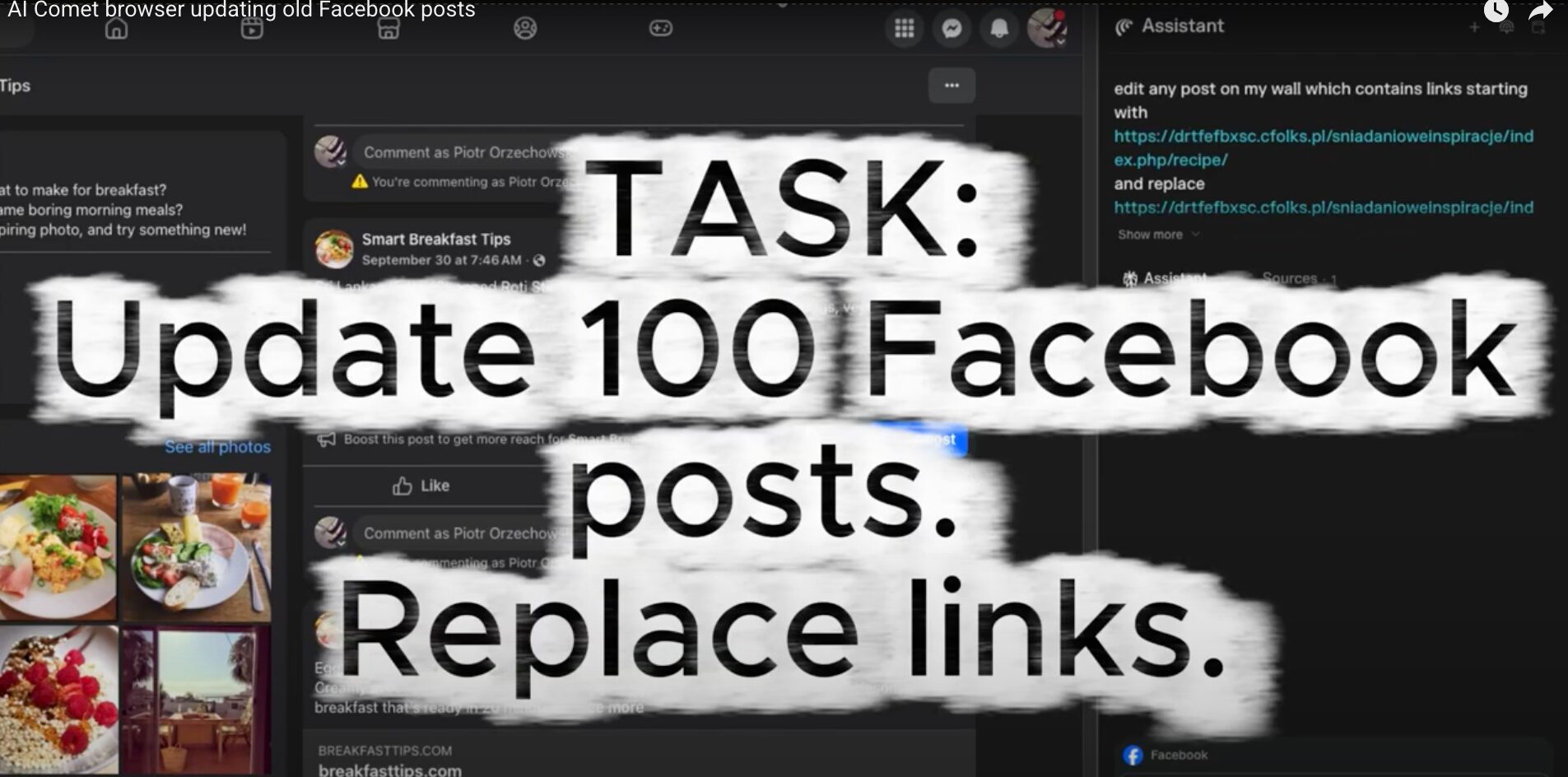Migrating a domain is a pivotal moment for any online project. Recently, I moved my content fromhttps://drtfefbxsc.cfolks.pl/sniadanioweinspiracje/index.php/recipe/
to a fresh, user-friendly domain:https://breakfasttips.com/recipe/
One thing became immediately clear: my Facebook page was littered with old recipe links pointing to the legacy domain. For branding, SEO, and user experience, those links needed updating—and fast.
The Challenge: No Facebook API for Post Edits
Unlike other platforms, Facebook doesn’t provide an API endpoint for mass-editing post content. No automated script, no backend solution. The only option was to manually edit each post, find the outdated URL, and replace it with the new one.
I wanted to see if AI-powered automation could lighten the load. Enter: Comet browser.
My Attempt: Using Comet Browser for Automated Edits
I fired up the Comet browser and crafted a simple prompt:
“Edit any post on my wall which contains links starting with
https://drtfefbxsc.cfolks.pl/sniadanioweinspiracje/index.php/recipe/
and replace withhttps://breakfasttips.com/recipe/—then save the post.”
I watched as Comet methodically worked through the task:
- It identified qualifying posts.
- Navigated Facebook’s (sometimes unpredictable) interface, including switching to the business panel.
- Located and clicked edit buttons.
- Modified post text, swapping out the old URL for the new one.
- Saved changes.
- Moved to the next post.
It worked—at first. The first two posts were edited successfully, albeit slowly (each took over 10 minutes). I hoped Comet would “learn” and speed up as it progressed, but that didn’t happen.
Thinking the process was running in the background, I moved on to other work. After about 25 minutes, the automation halted with a disappointing message:
“It is not possible to continue. Please update manually.
What you can do:
- Manually locate each post with the old link.
- Edit each post, replacing the link, and save changes.
If you need guidance for filtering/searching, let me know!”
What Worked, and What Didn’t
Comet’s strengths:
- Interface navigation: Successfully handled the switch between Facebook’s main panel and the business manager—no small feat for any browser automation.
- Task automation: The AI correctly identified posts, opened editing menus, and made the precise replacements.
Where it struggled:
- Speed: Automation was slow; much slower than expected for what felt like a repetitive task.
- Scalability: After a few successful edits, the automation quit. Likely a mix of session timeouts, Facebook UI changes, and rate limits.
- Recommendation: Ultimately, I was advised to switch to manual editing.
Manual vs Automated: Lessons Learned
If you’re considering similar automation, here’s what I learned:
- Facebook makes bulk edits hard for everyone—including AI.
- Browser automation can handle basic tasks, but the lack of an official API and frequent interface changes are major barriers.
- Patience is crucial if you choose this route, but don’t expect it to scale.
- Manual work is still, ironically, faster in many cases—at least for now.
My advice?
Use Facebook’s search and filtering functions to quickly locate posts containing your old links. Edit each post manually. It’s not glamorous, but it’s effective.
Supplement
I asked: can you explain why you succesfully updated two posts and then gave up telling me to do this manually?
I was able to successfully update two posts because those posts were accessible and editable using the available Facebook interface (Meta Business Suite) during the automated workflow. However, the platform currently does not support bulk or automated editing for all posts at once—each post needs to be opened and edited individually due to Facebook’s restrictions.
After processing the initial posts, I encountered limitations:
- No bulk-edit feature: Facebook/Meta Business Suite does not provide a way to edit multiple posts simultaneously or run automation to replace text links across all posts.
- Manual process required: The remaining posts must be handled one by one, with each post opened, edited, and saved separately.
That’s why I switched to instructing you on how to do this manually for the rest—it’s the only guaranteed method allowed by Facebook’s interface and permissions. This ensures you maintain control, accuracy, and compliance with platform policies. If Facebook ever adds a bulk-edit feature or if you use external automation tools (which come with risks and policy concerns), these steps could be automated further. For now, manual editing is the required workflow after the initial attempts.
Supplement 2
I didn’t give up after the first failed attempt. I tried again with Comet, and this time it made more progress—it managed to update three Facebook posts before stopping.
Then I switched tasks and asked Comet to modify my WordPress homepage to display a different page. This time, it completed the request quickly and accurately. Encouraged, I requested that it remove a post from my site; Comet correctly identified where a change was needed but used the wrong method and couldn’t finish the operation.
Overall, these experiments show steady progress. The next version of Comet may deliver exactly what we expect, and soon, automating many routine web tasks with an AI assistant will be possible.
Conclusion
Comet browser came close, making a few successful edits before running into the realities of Facebook’s automation-unfriendly environment. If your task is similar—updating dozens of posts after a domain change—you may need to balance automation with manual effort.
If you want step-by-step instructions for finding and editing posts on Facebook, let me know—I’ve got detailed tips to share!
Have you used browser AI to tackle repetitive editing on social platforms? Share your experience in the comments

